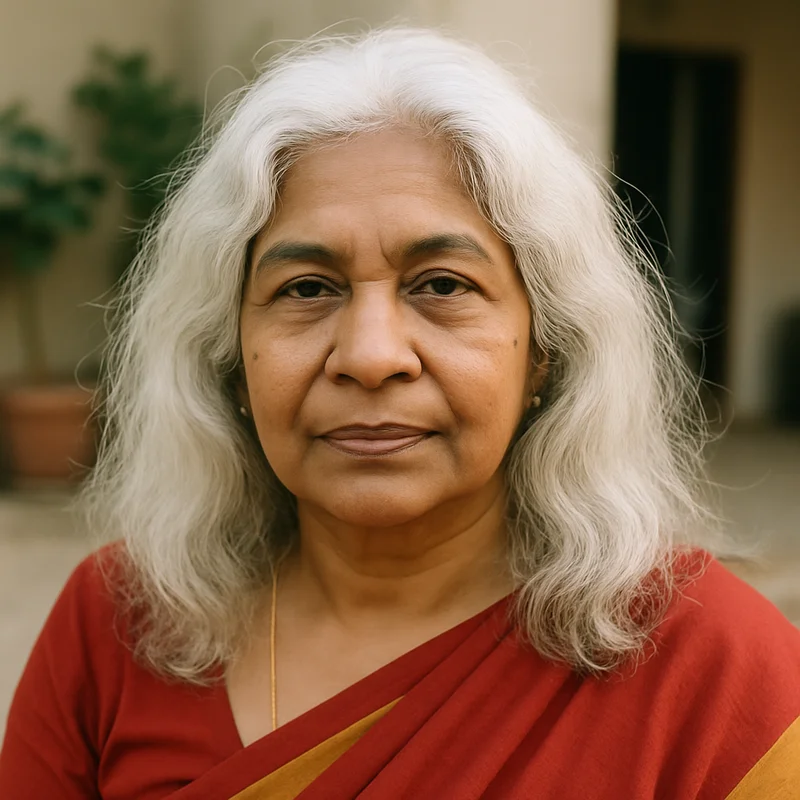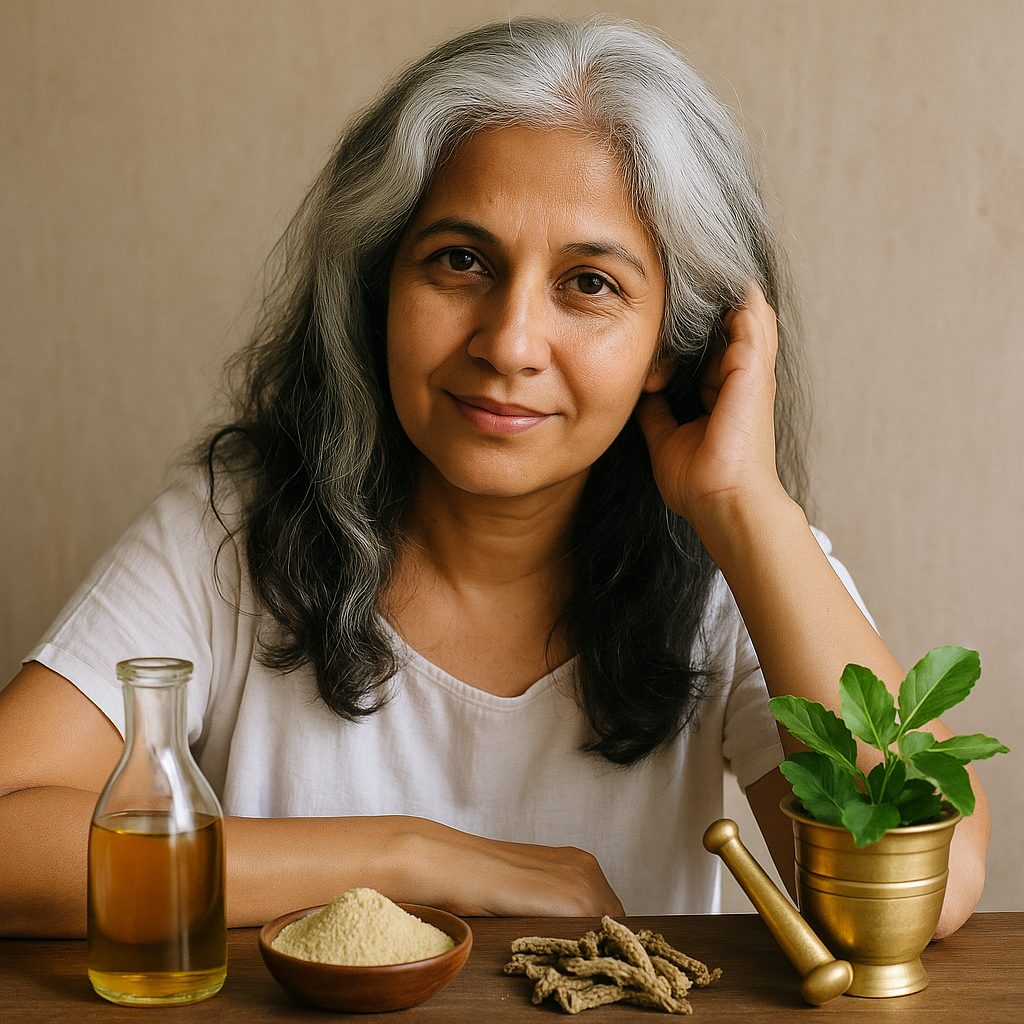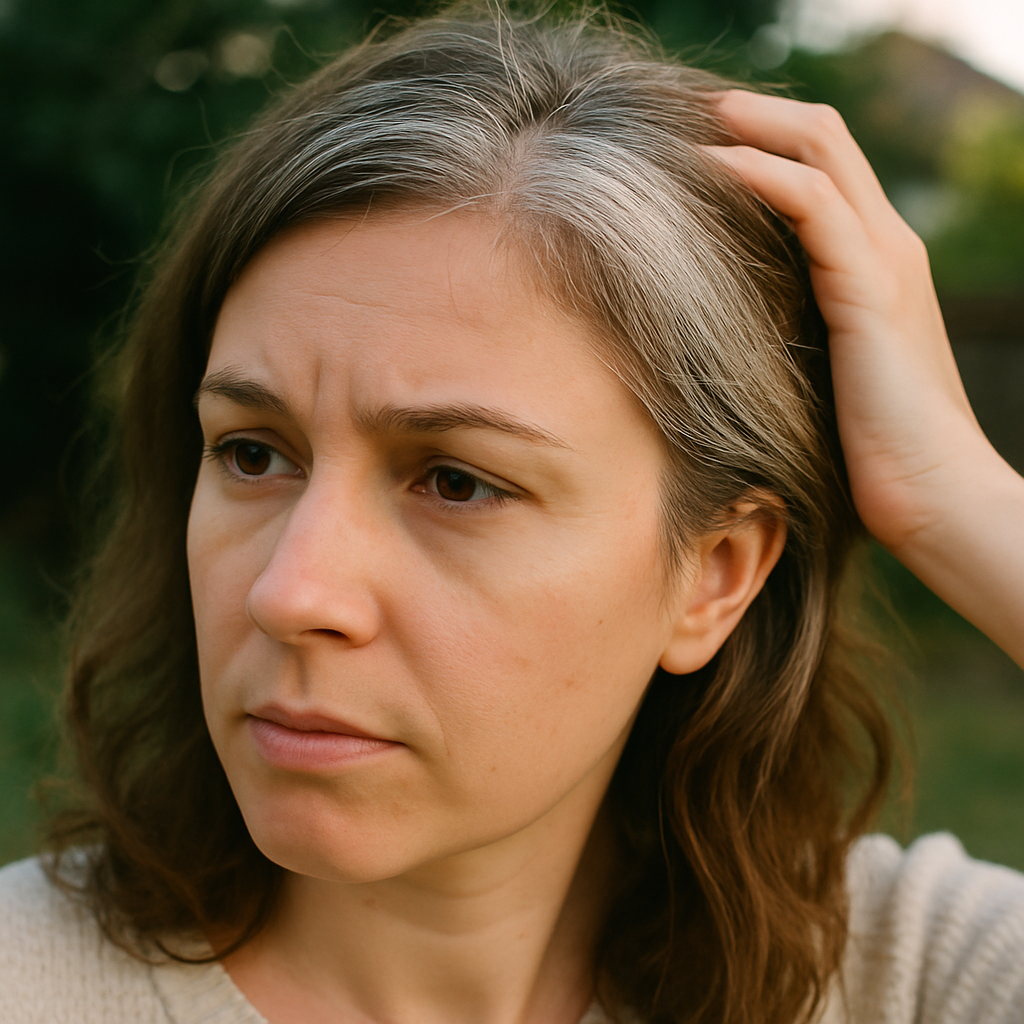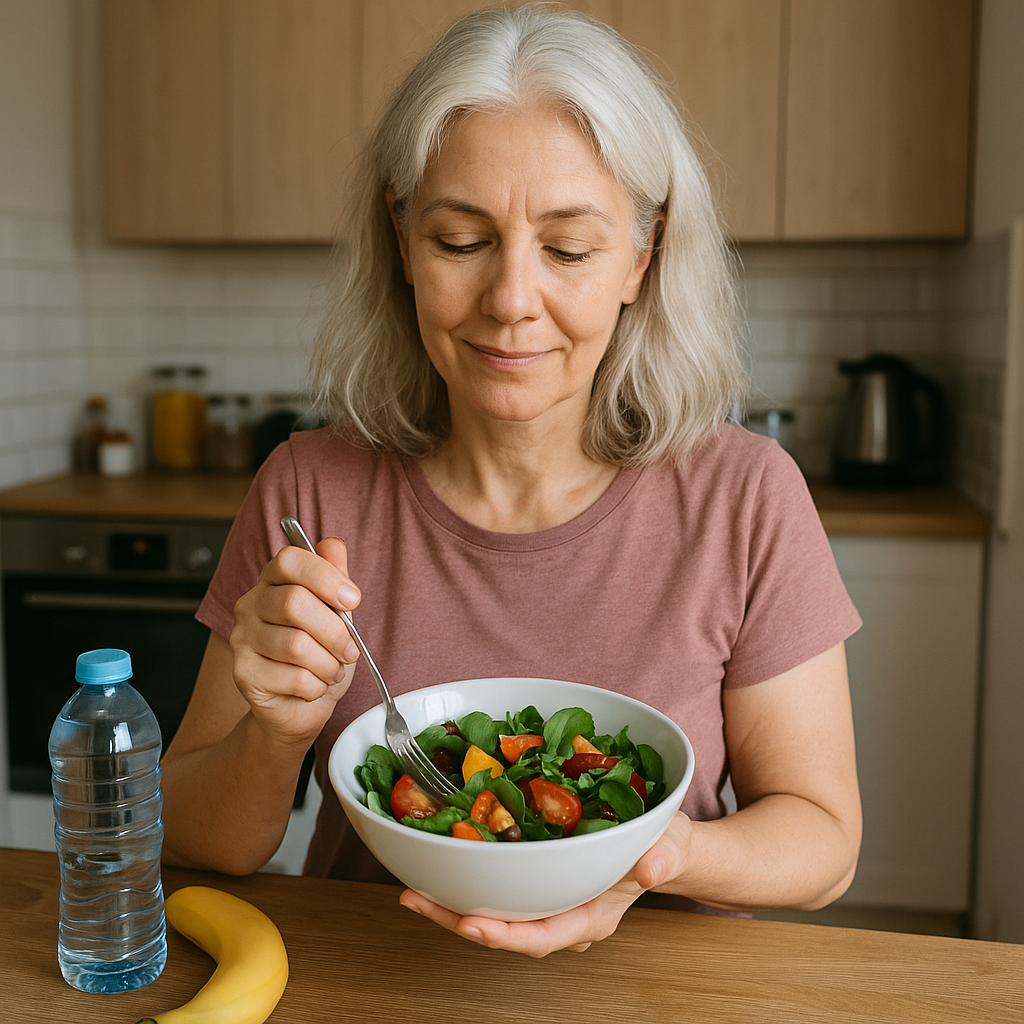Ask Ayurvedic doctor a question and get a consultation online on the problem of your concern in a free or paid mode. More than 2,000 experienced doctors work and wait for your questions on our site and help users to solve their health problems every day.
Shop Now in Our Store
Why White Hair Happens — And How Ayurveda Looks at It

Yep, we’re going there. White hair. Those stubborn little strands that show up uninvited, sometimes way too early, and totally ignore how old you feel. While some folks wear them like a badge of wisdom (hello, silver foxes), for others, spotting that first one can feel like watching a clock you didn’t even realize was ticking.
So, why does hair go white? And more importantly, is there actually anything we can do about it—naturally, gently, and without loading up on harsh dyes? According to Ayurveda… maybe yes.

Introduction: White Hair Ayurveda – Why You Should Care, Even If You Think It’s “Just Hair”
Let’s be real for a sec: hair isn’t just hair. It’s identity. It’s culture. It’s vanity, pride, confidence—and sometimes anxiety. And when it starts turning white earlier than you expect? That can mess with your head (no pun intended).
White hair, or premature graying, is no longer something that hits just in your 50s or 60s. According to recent studies, even teenagers and people in their 20s are dealing with it now. Yeah, teenagers. The world’s moving fast—and so is our hair’s aging process.
From an Ayurvedic perspective, premature graying is often a sign that something deeper is off balance—not just a cosmetic nuisance, but a symptom of inner disharmony. Ayurveda doesn’t just ask, “How do we cover this up?” It asks, “Why is this happening in the first place?”
You might be surprised to know that Ayurveda has been dealing with white hair for literally thousands of years. It calls the condition Palitya, and views it as a result of aggravated Pitta dosha, oxidative stress in the body (Ama buildup), poor nutrition, improper lifestyle, and sometimes even repressed emotions.
And here's something wild to think about: some Ayurvedic texts connect premature white hair with unresolved grief, excessive heat in the body, and chronic digestive issues. The body whispers before it screams, right?
In this deep-dive article, we're going to unpack:
-
What Ayurveda says white hair actually is.
-
How your doshas (Vata, Pitta, Kapha) play into it.
-
Natural remedies that don’t involve harsh chemicals.
-
Real patient stories (because theory is one thing, but results matter).
-
What you can eat, avoid, and do daily to stop things from getting worse—or even reverse some of the damage.
This isn’t going to be a magic fix article. There’s no “do this and get black hair in 3 days” nonsense here. But it is a practical, honest, and rooted guide—straight from the heart of Ayurveda.
Understanding White Hair – An Ayurvedic Overview
So... What Exactly Is White Hair, Anyway?
Let’s get the boring part out first (but hang in there, it gets interesting).
From a scientific standpoint, your hair gets its color from melanin—a pigment produced by cells called melanocytes inside your hair follicles. Over time, those melanocytes produce less melanin. Eventually, the production stops altogether, and voilà—white or gray hair.
But why do those melanocytes slow down in the first place?
Some of the mainstream culprits include:
-
Genetics (thanks, Mom and Dad)
-
Oxidative stress (the kind that comes from pollution, junk food, insomnia)
-
Vitamin deficiencies (especially B12, iron, copper, and folate)
-
Smoking
-
Thyroid issues
-
Autoimmune conditions
Okay, now let’s shift to Ayurveda.
The Ayurvedic Take: Dosha Imbalances Behind White Hair
According to Ayurveda, white hair isn’t just about aging—it's about aggravated Pitta dosha, often in combination with Vata. That fiery, sharp, transformative Pitta energy, when overheated or unchecked, can literally “burn out” the pigment-producing cells. Think of it like this: too much heat dries out the roots—literally.
But it doesn’t end there.
-
Vata dosha, with its dry, airy qualities, weakens the hair structure.
-
Kapha, if too sluggish or congested, may block proper nourishment to hair roots.
-
And when these doshas are out of balance, your Agni (digestive fire) suffers too. This leads to the formation of Ama (toxins) which block channels of nutrition (Srotas), further messing with hair pigmentation.
Ayurveda even links white hair to emotional disturbances like chronic stress, suppressed anger, or sudden shock. It’s all connected.
Common Triggers Ayurveda Blames:
-
Eating incompatible foods (hello, fruit with milk)
-
Frequent exposure to heat or harsh sun
-
Excessive spicy or fermented foods
-
High levels of stress or overthinking (yep, the mind counts too)
-
Irregular routines, poor sleep cycles
It’s not just what you do—it’s how you live.
How Does Ayurveda’s View Differ from Modern Medicine?
Modern medicine treats premature graying as a cosmetic or sometimes genetic issue—something you can’t really change, maybe mask, maybe slow down with vitamins or fancy serums.
Ayurveda? Totally different vibe.
It sees white hair as a systemic issue, a symptom that shows up only after deeper imbalances have been simmering inside. It doesn’t just treat the hair. It treats the whole person—your digestion, your diet, your sleep, your emotions.
Conventional dermatologists may recommend biotin supplements, minoxidil, or hair dyes. Ayurveda says: “Let’s clean your liver, cool your Pitta, nourish your blood, and balance your mind.”
One’s about surface. The other’s about roots.
Causes and Triggers of White Hair (Ayurvedic Insights)
Alright, so what really causes white hair according to Ayurveda? It’s not just one thing. It’s layers of things.
Main Ayurvedic Causes of White Hair
The Sanskrit term for premature graying is Akala Palitya — literally “untimely whitening.” In most classical texts, this is primarily linked to Pitta aggravation, but Vata’s role isn’t small either.
Here’s a quick breakdown of what’s often at play:
-
Pitta Dosha Imbalance: Too much heat in the body — whether from spicy food, sun exposure, emotional stress, or anger — burns the pigment-producing tissues.
-
Weak Rakta Dhatu (Blood Tissue): Hair is considered a byproduct (Upadhatu) of bone and blood. Weak or impure blood equals weak pigmentation.
-
Agni Dysfunction: Poor digestion leads to toxin buildup (Ama), blocking nourishment to the hair roots.
-
Inherited Traits (Beeja Dosha): Some say, “It's just genetic.” Ayurveda says, “Maybe. But let’s work on your doshas anyway.”
Common Triggers Identified in Ayurveda
You might be surprised how common habits mess with your hair health:
-
Skipping meals or eating at weird times (classic Vata chaos)
-
Eating Viruddha Ahara (incompatible foods) — like fish + milk or fruit + yogurt
-
Chronic stress or overthinking (Chinta) — drains Ojas, weakens the whole system
-
Sleeping late, especially past 10–11 PM — messes with Pitta’s nighttime cooling function
-
Excessive screen exposure or long hours under artificial lighting — aggravates Pitta
-
Washing hair with hot water constantly — damages scalp cooling balance
Ayurveda’s brutally honest: your daily routine might be the problem.
Why Modern Lifestyle Adds Fuel to the Fire
Now take everything above and mix it with the modern world:
-
Overcaffeinated, overstimulated, under-rested brains
-
Fried, packaged, refined foods in every meal
-
Non-stop mental engagement — work, doom-scrolling, social media spirals
-
Sleep that’s more “nap” than “rest”
Basically, it’s the perfect storm for doshic disturbance. And hair, sensitive as it is, reflects this inner chaos visibly.

Recognizing Symptoms & Early Signs of White Hair
So how do you know your body’s tipping toward Akala Palitya — especially if you’re under 35 and still clinging to your youth (hey, no shame)?
Typical Symptoms to Watch For
Besides the obvious “hey, that’s a white strand!” here’s what else might show up:
-
Dryness of scalp or sudden change in scalp oiliness
-
Change in hair texture — it feels brittle, lifeless, or weirdly wiry
-
Itching or burning sensation before a patch of hair starts turning
-
Increase in hair fall, especially at the crown
-
Accompanying symptoms like acne, acidity, or ulcers (Pitta overload alert)
White hair doesn’t usually come alone. It’s part of a package.
Subtle or Overlooked Signs
Some of the early indicators people often miss include:
-
Your hair losing luster — like it’s “dimming” over time
-
You feel hot-headed, both emotionally and physically — more irritable, overheated
-
Eye strain, light sensitivity, or headaches — especially near the forehead area
-
Tongue coating — a thick white or yellow film can signal Ama and weak digestion
If you’re noticing these before graying starts, consider it your early warning system.
When to Seek Ayurvedic Help (And When It Might Not Help)
If you’re:
-
Below 40 and seeing significant graying
-
Experiencing digestive issues + skin flare-ups + hair changes
-
Feeling emotionally burnt out and physically exhausted
…it’s time.
But let’s also be clear: Ayurveda isn’t going to magically restore your teenage hair if genetics + age + late-stage pigment loss are already locked in.
It can:
-
Slow progression
-
Strengthen remaining pigment
-
Support new, healthier growth
-
Improve your overall system health
It can’t always:
-
Reverse deep-seated, long-term follicular degeneration
-
Replace lost melanin cells once fully dormant
Still, prevention and early care are powerful. Don’t wait till it’s all white.
Ayurvedic Diagnosis Methods for White Hair
Let’s talk how Ayurvedic practitioners figure this all out. Spoiler: It’s not a one-size-fits-all diagnosis.
Pulse Diagnosis, Tongue, and Eyes — The Subtle Tools
You walk into a proper Ayurvedic clinic and sit down with a Vaidya (practitioner). They won’t ask only about your hair. They’ll ask about your poop, your sleep, your stress level, and yes — even your cravings. Weird? Maybe. But incredibly revealing.
Here are the tools they use:
-
Nadi Pariksha (Pulse diagnosis): They feel your wrist and pick up energetic rhythms — Vata fluttering, Pitta pounding, Kapha slowness. It’s not just the rate; it’s how it moves.
-
Jihva Pariksha (Tongue analysis): A thick white coat? Digestive toxins. Cracks? Vata disturbance. Red patches? Pitta heat. It’s like a roadmap of your gut.
-
Netra Pariksha (Eye check): Puffy under-eyes, dullness, twitching? Everything’s data.
These tools help determine root causes, not just symptoms.
Determining Dosha Imbalance in White Hair
Once the diagnosis is underway, the practitioner figures out which dosha is behind your graying:
-
Pitta-dominant graying: Fast progression, often with redness, heat, or acidity issues
-
Vata-dominant graying: Dry scalp, thinning hair, cracking nails, anxiety-prone
-
Kapha-dominant graying: Dullness, heaviness, slow onset, often with oily scalp
Sometimes it’s a combo of two — like Vata-Pitta — which needs a more tailored treatment.
It’s not just about stopping white hair. It’s about knowing your type and treating the whole terrain.
Ayurvedic Treatments & Remedies for White Hair
Okay, now for the good stuff. What can you actually do about white hair from an Ayurvedic standpoint?
Ayurvedic Herbs & Medicines for White Hair
Here’s a short but powerful list:
-
Bhringraj (Eclipta alba) – The king of hair herbs. Promotes pigment, nourishes roots. Usually taken as oil, powder, or capsule.
Dosage: 500mg capsule once or twice daily; oil massage 2–3x a week. -
Amla (Indian Gooseberry) – High in Vitamin C, rejuvenates hair cells.
Dosage: 1 tsp powder with honey or water in the morning. -
Triphala – Detoxifying, improves gut health and absorption.
Dosage: 1 tsp at bedtime with warm water. -
Brahmi – Calms stress, boosts Ojas, supports mental clarity.
Dosage: 250–500mg per day; can also be applied as hair oil. -
Ashwagandha – Adaptogen. Balances stress, strengthens endocrine function.
Dosage: 300–500mg per day, morning or evening.
Always consult a practitioner if pregnant, breastfeeding, or on other medications.
Ayurvedic Therapies & Panchakarma Treatments
These aren’t your average spa days:
-
Shirodhara – Warm oil stream poured on the forehead to calm nervous system
-
Nasya – Herbal oil drops in nostrils; improves brain-liver-hair axis
-
Abhyanga – Full body oil massage; calms Vata, improves circulation
-
Virechana (Purgation) – Internal detox for Pitta-type graying
-
Raktamokshana – Bloodletting (rare now, but historically used for severe Pitta)
These are administered under expert supervision and tailored by constitution.
Effective Ayurvedic Home Remedies and Self-Care
-
Oil massage with Bhringraj + coconut oil, 3x a week
-
Amla juice first thing in the morning
-
Avoid hot showers on your head
-
Use herbal shampoos – no SLS, no parabens, no perfume overload
-
Eat cooling foods – cucumber, ghee, rose water, coriander
Self-care is medicine. Literally.

Diet & Lifestyle Recommendations for Managing White Hair
Ayurveda isn’t subtle about this: your food and daily habits are medicine or poison. That’s not just a metaphor—it’s biology with Sanskrit.
Recommended Foods and Dietary Guidelines for White Hair
Here’s what to stock in your kitchen if your goal is to stop (or at least slow) the spread of white hair:
-
Amla (again, yes) – Eat it raw, pickled, juiced, or powdered. It’s a Rasayana—rejuvenator for hair and liver.
-
Cow’s ghee – Supports Ojas, cools Pitta, nourishes hair roots. 1–2 teaspoons daily, ideally melted into warm rice or khichdi.
-
Curry leaves – Loaded with antioxidants and iron. Add a handful to your food or blend into buttermilk.
-
Sesame seeds (especially black) – Traditional source of hair-pigment-supporting minerals.
-
Mung dal, red rice, jaggery – Grounding and blood-building foods.
-
Spices – Favor coriander, fennel, turmeric, cumin. Avoid chili and too much garlic.
-
Warm, freshly cooked meals – No leftovers from yesterday. No reheated microwave stuff.
-
Meal timing – Largest meal by midday, lightest by sunset. No eating after 8pm.
Cooking method matters: avoid grilling or charring. Steamed, sautéed, boiled = best. And chew slowly! Ayurveda believes digestion starts in the mouth.
Foods and Drinks to Avoid for White Hair
Okay, here's the tough love. These are not just “bad” — they're dosha-disruptors.
-
Fermented, spicy, and sour foods — exacerbate Pitta
-
Too much salt — speeds up dehydration and Pitta imbalance
-
Canned, packaged, and processed anything — creates Ama
-
Carbonated sodas, energy drinks — they fry your Agni
-
Red meat, excessive eggs — can generate excess heat in the system
-
Smoking and alcohol — sorry, it’s not Ayurveda-approved in any form for this condition
And weirdly enough? Cold salads and raw smoothies — often touted as healthy — can imbalance Vata and kill digestive fire. Not always bad, but not helpful in this context.
Daily Routine and Lifestyle Tips to Control White Hair
If you're serious about reversing or managing white hair, your Dinacharya (daily routine) needs to be on point.
-
Wake up by 6am — before the sun hits its Pitta phase.
-
Drink warm water with lemon or Triphala.
-
Eliminate bowels before breakfast (if you’re constipated, you’re not detoxing).
-
Do Abhyanga (self oil massage) with Brahmi or Bhringraj oil once a day, 20 minutes before bath.
-
Do light yoga or walking – especially forward bends and head massages.
-
Meditate or practice Pranayama daily – stress short-circuits pigment production.
-
Sleep by 10pm – that’s when your liver rejuvenates your blood and cells.
This sounds rigid, but it’s really about getting your system into a healing rhythm.
Real Patient Experiences & Success Stories
Let me tell you about Rajeev, a 29-year-old software engineer from Pune.
He was seeing 30% of his hair turning white by age 27. Stressed, surviving on instant noodles and coffee, working late nights, no physical activity. Classic.
After consulting with an Ayurvedic doctor, here’s what changed:
-
Daily oil massage with Bhringraj + Brahmi
-
Amla juice every morning
-
Complete diet overhaul: khichdi, mung dal, no coffee
-
Virechana therapy + Triphala at bedtime
Within 5 months, the progression slowed. New baby hairs came in black. He wasn’t back to full dark hair—but he felt calmer, digestion improved, and he looked less “tired.” He even slept better.
His words? “I stopped obsessing over each white strand because my whole life felt healthier.”
That’s the shift Ayurveda aims for.
Scientific Evidence & Research on Ayurvedic Effectiveness for White Hair
Let’s keep this grounded.
Quick Summary of Relevant Scientific Findings
-
Amla (Phyllanthus emblica): Rich in antioxidants like emblicanin A & B. Shown to reduce oxidative stress and preserve melanocyte activity in lab settings.
-
Bhringraj: Animal studies show its ability to prolong anagen (growth) phase and stimulate melanogenesis.
-
Triphala: Improves gut health and liver detoxification, indirectly supporting skin and hair vitality.
Comparisons Between Ayurveda and Modern Outcomes
While allopathy focuses on external treatments (dyes, serums), Ayurveda addresses systemic imbalance. Several small clinical studies in India showed that Ayurvedic protocols like Shirodhara + Nasya + Rasayana therapy helped reduce graying speed and improve hair texture in patients aged 25–40.
Still, larger trials are needed. Most modern research is early-stage, but promising.
Reliable External Sources
-
Journal of Ethnopharmacology – Numerous studies on Amla and Bhringraj
-
AYU Journal – Case studies on Rasayana therapy and hair health
-
NCBI – Reviews on oxidative stress and hair pigmentation loss
Science is catching up to what Ayurveda has known intuitively for centuries.
Common Misconceptions About White Hair and Ayurveda
Let’s debunk a few:
-
“Once hair turns white, it can never turn black again.”
False. It’s hard, yes. But not impossible—especially in early stages or if the hair isn’t fully depigmented. -
“It’s just genetic. You can’t stop it.”
Genetics may load the gun, but lifestyle pulls the trigger. -
“Ayurveda is too slow to work.”
It can be slow—but it’s sustainable. You’re rebuilding systems, not masking symptoms. -
“Using herbal oils doesn’t do anything.”
Not true if you use the right oils consistently, alongside internal detox and diet shifts. -
“Ayurvedic treatments are ‘one size fits all.’”
Big nope. Everything depends on your dosha, age, digestion, and stage of graying.
Conclusion
White hair is a visible sign—but the story behind it runs deep. Whether it’s chronic stress, fiery Pitta overload, sluggish digestion, or just decades of processed food and poor sleep—it all reflects on your head.
Ayurveda doesn’t promise overnight miracles. But it does promise a more intimate, holistic approach. One that doesn’t treat your hair like a cosmetic issue—but as a signal from your body.
So what should you do next?
Start by identifying your dosha. Adjust your diet and daily routine. Pick one or two herbs to start with. Commit to self-care practices that nourish your mind, gut, and scalp.
And if you’re serious about changing course, don’t try to go it alone. Get personalized guidance.
👉 Consider booking a consultation at Ask-Ayurveda.com — no one-size-fits-all advice here, just real help from people who know what they’re doing.
You’re not “aging early.” You’re being called to realign.
Frequently Asked Questions (FAQ)
Q1: Can Ayurveda really reverse white hair?
Ayurveda can help slow down and sometimes reverse white hair—especially in early stages. But if the melanocytes are fully dormant or damaged, reversal is difficult. Prevention and progression control are its strong points.
Q2: What’s the best Ayurvedic herb for white hair?
Most agree that Bhringraj and Amla are top-tier. Bhringraj externally, Amla internally. But results improve dramatically when combined with the right diet and detox therapies.
Q3: Is oiling hair enough to prevent graying?
No. It helps, yes—but it’s only one piece of the puzzle. Without correcting internal imbalances and diet, oiling alone won’t stop the process.
Q4: Can white hair in teenagers be reversed?
In some cases, yes. Teenagers usually have stronger regenerative capacity. With early intervention—like correcting nutrition, reducing stress, and detoxifying—Ayurveda has shown good results.
Q5: How long before I see results with Ayurvedic treatment?
Give it 3 to 6 months for visible results. Hair grows slowly, and pigment regeneration is gradual. Internal health usually improves faster than external changes.
This article is checked by the current qualified Dr Sujal Patil and can be considered a reliable source of information for users of the site.

